
COVID-19 brought a new sense of urgency to digital manufacturing, but M4.0 leadership is still a work in progress, reveals the Manufacturing Leadership Council’s new survey on Next Generation Leadership and the Changing Workforce.
By Penelope Brown

In many ways, the coronavirus pandemic has forced a reckoning with Manufacturing 4.0 and many of its dimensions. In the technology space, it has meant relying on data to help overcome shifts in demand, supply shortages, and, in some cases, the need to institute remote operations. For organizations, it has meant shifting employees’ physical work locations and implementing sometimes complex social distancing protocols at production sites.
For leadership, however, the reckoning may be most pronounced. When the crisis hit, leaders were charged with making decisions for which there was no precedent. They needed to communicate with their teams and colleagues around the clock. They often needed to set up an entirely new infrastructure to keep operations going. Perhaps most importantly of all, they needed to maintain a calm and measured approach at a time of high anxiety, doing their best to ease employees’ fears when they very likely had many fears of their own.
Part 1: Defining the Leadership Role
1 Leadership means data,
collaboration, and integration
Q: Which statement best describes what leadership means in the Manufacturing 4.0 era?
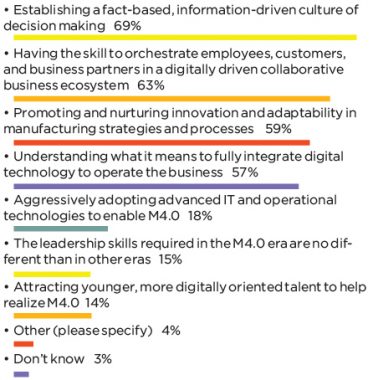
2 COVID-19 has added urgency to M4.0 investment
Q: To what extent has the COVID-19 pandemic created a greater sense of urgency about M4.0 digitization within your company’s leadership ranks?
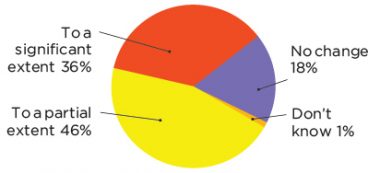
3 Most agree that M4.0 leadership requires a different approach
Q: Please indicate the extent to which you agree with this statement: The emergence of the M4.0 era of information-driven factories will require a substantially different approach and set of skills on the part of manufacturing company leadership.
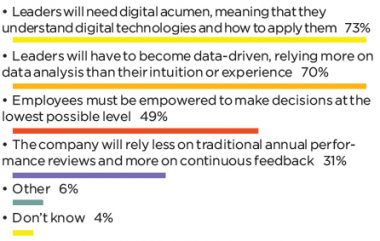
4 Digital acumen is a leader’s
most important skill
Q: Which new approaches and skills do you feel will be most important for the M4.0 era?
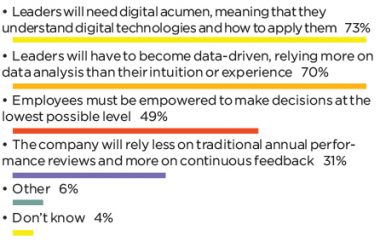
5 Few executive teams have
strong M4.0 knowledge
Q: What level of knowledge does your company’s executive management team have today about the concept of M4.0, its requirements, and its challenges?
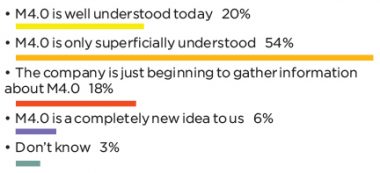
But when it came to M4.0, a gap that has been in evidence for the past few years between the perceived importance of digitization and leaderships’ ability to manage a digital-first operation came into sharp relief.
This is one of the key findings of the Manufacturing Leadership Council’s new survey on Next-Generation Leadership and the Changing Workforce, one of MLC’s Critical Issues facing manufacturing in the digital era. For purposes of the survey, an M4.0 leader is described as one who establishes a fact-based culture of decision making and who has the skills to orchestrate the enterprise in a digital, collaborative ecosystem. These two competencies have been essential to manufacturers’ response to the pandemic. Anxieties and fears can be allayed with facts and information, and many leaders have said that their digital technologies were indispensable in pivoting operations quickly, and in some cases improved performance even over pre-pandemic levels.
Results from this survey also examine the current state of leadership M4.0 preparedness, the future digital skills that companies will need, the differing viewpoints between operations leadership and executive leadership, and what skills leaders need to build for the collaborative, digital, and always uncertain future.

Most leaders don’t deny the importance of M4.0, but there are sometimes clashes between the C-suite and operational leaders regarding its degree of importance.
6 Execs biggest question: What’s the M4.0 business case?
Q: What’s the most important thing your company’s executive management team wants to know about M4.0?
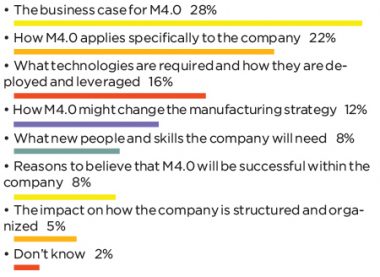
7 Leadership only partially prepared for M4.0
Q: How prepared do you think your company’s executive management team is to lead and manage the journey to M4.0?

8 Separate issues take focus from M4.0 preparation
Q: If your company’s executive management is not well prepared for M4.0, what is the most important reason why?
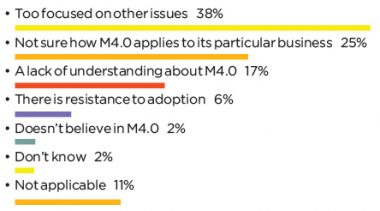
9 More than half see success threatened by lack of preparedness
Q: How vulnerable will your company’s future success be as a direct result of your company’s current level of M4.0 preparedness?

10 A majority of operations leaders cite importance of M4.0
Q: What degree of importance does manufacturing operations leadership attach to M4.0?
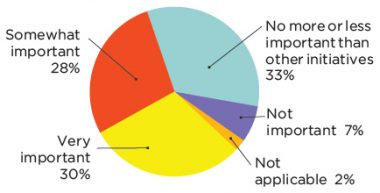
A Sense of Urgency
While the pandemic underscored the necessity for the digital factory, the organizational ability to lead and manage a digital-first operation is lagging for many manufacturers. While 82% of respondents said the pandemic brought about a greater sense of urgency about M4.0 digitization at their company to either a partial or significant extent (chart 2), only 20% said that M4.0 is well understood by their executive management team (chart 5).
Additionally, most do not feel that their executive leadership is well prepared to lead and manage the journey to M4.0, with only 13% saying those executives are very prepared (chart 7) and 20% saying they aren’t prepared at all. The most-cited reason for the lack of preparation was that leaders are too focused on other issues (38%) or they weren’t sure how M4.0 applied to their business (25%) (chart 8).
While leaders have a need to develop their own digital knowledge and skills, they also must determine what their future organizational structure will look like and what roles are necessary to fulfill business objectives and goals. That outlook continues to be hazy for the digital future, as just 8% said those roles were well understood at their companies, with most respondents (61%) saying they were only somewhat understood (chart 18).
11 Most C-suites believe M4.0 is important
Q: What degree of importance does C-suite business leadership attach to Manufacturing 4.0
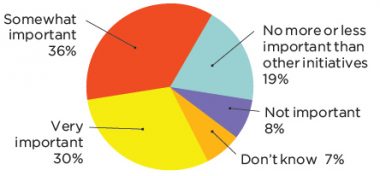
12 Many companies lack organizational vision for M4.0
Q: If there is a difference between the degree of importance attached to M4.0 by manufacturing operational leadership and C-suite leadership, which of the following statements best describe why?
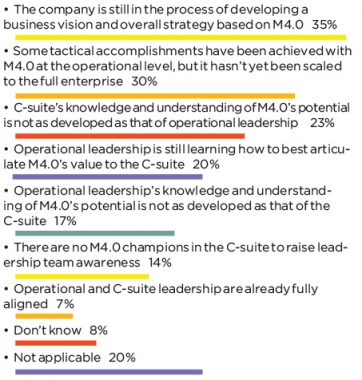
It seems that most companies have an awareness of their needs, but many have not yet done what is necessary to address them. In that regard, 79% of companies have no formal training plan to educate their workers and leaders about M4.0 technologies and skills.
Leadership Quality Check
Many believe that a lack of M4.0 preparedness will be detrimental to future success, with 46% saying their company is moderately vulnerable and 8% very vulnerable (chart 9). The silver lining is that many leadership teams see the importance of digitization; 66% of C-suites believe M4.0 is either very important or somewhat important (chart 11). The same goes for 58% of operations leaders (chart 10).
But what qualities does an M4.0 leader need to have in order to develop, champion, and ultimately usher through to that era of significant digital change? For one, they need to become more familiar with digital manufacturing. Nearly three-fourths of respondents said that leaders will need digital acumen, or the understanding of digital technologies and how to apply them (chart 4).
They also need to walk the talk by leading through the use of data. It’s viewed as important to exercise fact-based leadership, with 70% saying that leaders must become more data-driven and make decisions based on facts rather than experience or gut feelings (chart 4).
Asked to identify the most important M4.0 leadership skill, most said it is the willingness and ability to rethink the business and successfully embrace a digital model (72%), followed by the ability to manage data across the business ecosystem (65%) and use analytics to make data-driven decisions (65%) (chart 13).
Part 2: Developing Knowledge and Expertise
13 Embracing a digital model is essential to success
Q: Looking ahead, what degree of importance would you assign to the following M4.0 leadership skills and abilities?
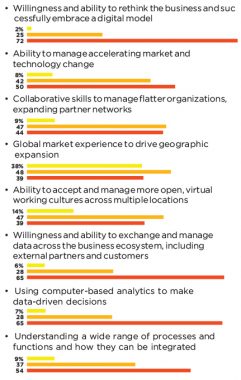
14 Data analytics, cybersecurity are top areas of emphasis
Q: Looking ahead, what degree of emphasis would you place on the following technology areas in terms of developing knowledge and expertise?
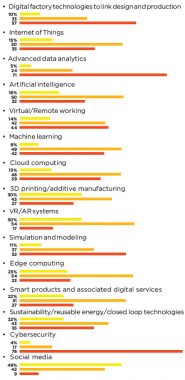
Part 3: Assessing Leadership Challenges
15 Most see future leaders already in the company
Q: Where do you see the next generation of leaders coming from for your company?
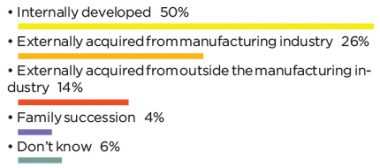
16 Digital roadmap, business model are top leadership challenges
Q: In thinking about the requirements and implications of M4.0, what do you think are the most important challenges for leadership?

17 Safety, communication emerge as new leadership priorities
Q: How have recent events changed leadership skills and behaviors for the future?
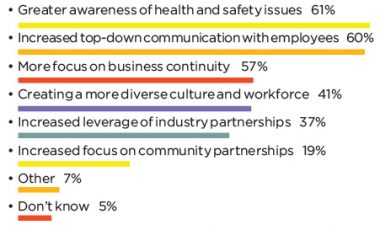
Part 4: Workforce Development and Transition
18 Necessary digital roles only partially understood
Q: How well prepared do you think your company is in understanding the new digital roles and skills that you will need in the next few years?

19 Most companies lack formal M4.0 training plan
Q: Does your company have a formal training plan to educate workers and leadership around the requirements of M4.0?
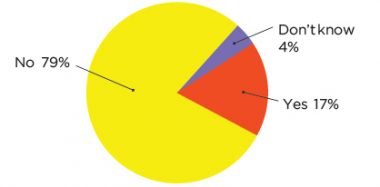
20 Automation aids in filling chronic worker shortages
Q: What impact do you think the increasing adoption of automation and advanced M4.0 technologies will have on workforce levels in your company in the future?
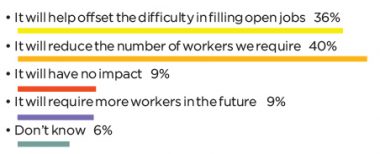
C-Suite vs. Operations
Whether at the operational or C-suite level, most leaders don’t deny the importance of M4.0. But some companies see a clash between those groups on the degree of importance. For 35%, development of an overall digital vision and strategy is still a work in progress and accounted for some of the differences (chart 12). A third said that tactical operational accomplishments had been achieved with M4.0, but those had not yet been scaled to the enterprise.
Indeed, the need to develop a technology roadmap was the most-cited challenge to leadership (chart 16), with 57% saying it remains a hurdle. Others said there was a need to understand the business case and return on investment (52%) and also to develop a viable digital business model (47%). The workforce factors in as well, with 46% saying it is necessary to change the business culture and attitudes of employees.

M4.0 leaders are charged with both improving their own digital acumen and leading through data and fact-based decision making.
COVID-19 and Leadership
If you ask any manufacturing leader about their experience over the last several months, you’re likely to hear things like “never would have believed it,” “biggest challenge of my career,” “once in a generation scenario,” “life-changing.” It’s undeniable that the pandemic crisis and other recent events have made an immense impact on leaders and what they will be taking with them into the future.
Most say that they now have a greater focus on health and safety (61%), increased top-down communication with employees (60%), and more focus on business continuity (57%) (chart 17). Others are thinking of how to improve diversity at their organizations (41%) or how to leverage their industry partnerships (37%) and community partnerships (19%).
It’s unlikely that much of business will return to what we knew as normal prior to the pandemic. What goes and what remains is yet to be seen. But steeped in a crisis they never could have conceived, leaders are now armed with a new set of lessons and skills that are likely to serve them through the future, in good times and bad. The pandemic has accelerated the timeline for the digital factory. Now, it’s time for leadership to catch up. M
Survey development was led by Penelope Brown, Content Director, with input from the MLC editorial team and the MLC’s Board of Governors.
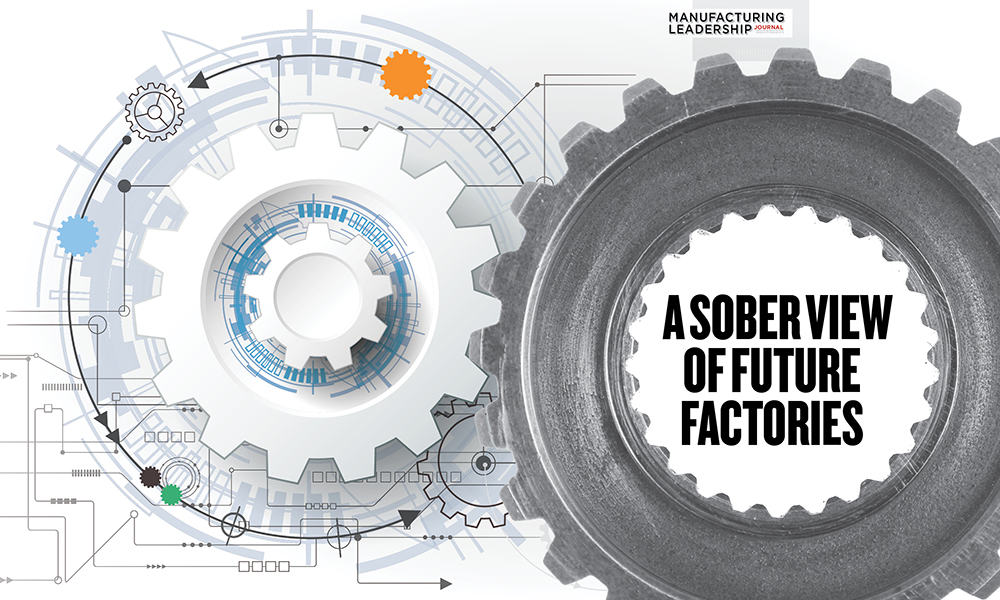
As they anticipate an accelerated adoption of new technologies over the next couple of years, manufacturers envision that factories and plants will be a mixture of the future and the past, reveals the MLC’s new Factories of the Future survey. By David R. Brousell
Those who are worried that future factories and plants will become lights-out facilities populated with artificial intelligence-powered super robots performing functions once done by flesh and blood human beings can rest easy – at least for the moment.
According to the Manufacturing Leadership Council’s latest Factories of the Future survey, manufacturers don’t share the dystopian vision of the industry often portrayed in popular culture, by think tank organizations, and even by some industry insiders. Instead, people on the front lines of plants and factories see a heterogeneous future, one that is clearly evolving to the digital state but which will be a mixed bag of people and automation for the foreseeable future.
When asked what they expected the future state of their factories to look like, 74% of the respondents to the MLC survey said they envisioned a hybrid of humans and robots, additive and subtractive processes, and digital and analog processes. Only 5.3% anticipated a future where factories are lights out and fully automated (Chart 8).
PART 1: STATUS OF M4.0 ADOPTION
1 More Than Half Undertaking
M4.0 Projects & Growth
Q: What is the overall progress level for M4.0 adoption in your company’s factory or plant operations?
2 Production, Quality Processes Most Advanced with M4.0
Q: At what stage of M4.0 adoption are the following functions in your company?
PART 1: MEASURING DIGITIZATION
3 Production & Nearly One-Quarter Has Digitized Equipment Maintenance
Q: To what extent is your plant floor equipment maintenance and service digitized today, and what extent do you anticipate it will be in 2 years’ time?
4 A Majority Has Digitized Production/Assembly
Q: To what extent is your production/assembly process
digitized today and what do you anticipate the extent will be IP-enabled in 2 years’ time?
5 Primary Most Have Networked, IP-Enabled Plant Floors
Q: How would you describe the extent to which your plant floor is networked and IP- enabled today, and what do you anticipate the extent will be in 2 years’ time?
This sober view no doubt reflects a realism borne from experience on the road to a digital future. As previous MLC surveys have shown, the digital journey is long, difficult, and often not linear. Rethinking processes in order to digitize them takes time and a lot of hard work. Figuring out what to do with increasing volumes of data from the many facets of operations requires analytical technologies and the people to manage them. And a successful pilot project doesn’t automatically mean applicability to the larger enterprise as issues of scale are confronted.
Despite the obstacles, manufacturers see a digitally-inspired future ahead, and one in which advanced technologies will have a profound impact on how plants and factories are run.
When asked whether they agree or disagree that AI and machine learning technologies will enable factories to become “self-learning facilities” in the future, for example, more than 85% of survey respondents supported the basic idea, with 23.4% of that group saying they “fully agree” with the concept (Chart 9).
Before such erudite facilities emerge, however, much distance has yet to be traveled on the road to Manufacturing 4.0, the MLC’s term for the next era of industrial progress based on digitization.
More than 85% of survey respondents expect their facilities to become “self-learning” in the future.
6 Nearly One-Third Are Linked to Customers, Suppliers
Q: To what extent are your production functions electronically integrated with customers and suppliers today and what do you anticipate will be the extent in 2 years’ time?
PART 1: FACTORY ORGANIZATION AND MANAGEMENT
[tooltip text=”Tooltip Text”]
7 Divergent Views on Future Factory Footprints
Q: Looking ahead, which statement most closely describes what your company’s future factory strategy will be?
8 Strong Majority Sees Hybrid Model in Future
Q: What is the expected future state of your factory model?
[tooltip text=”Tooltip Text”]
9 Self-Learning Factories Foreseen
Q: Thinking about the impact of technologies such as AI and machine learning, to what extent would you agree or disagree with the following statement: “Tomorrow’s factory will evolve to be a self-learning facility.”
[tooltip text=”Tooltip Text”]
10 Mixed Picture on Extent of Common Operating Platforms
Q: To what extent has your company established a
common operating platform at its factories?
Many in the Project Stage
According to the new survey, more than half of respondent organizations has undertaken M4.0 projects, with 30% experimenting with a range of small-scale pilot projects and 29% implementing projects on a single-project basis (Chart 1). Although many projects are at an early stage, most advanced at this point in time are projects in production and assembly and in quality operations (Chart 2).
But, as has been indicated in prior surveys, manufacturers’ intentions to digitize their various processes are remarkably strong.
For example, when asked to what extent they have digitized plant floor equipment and maintenance today, more than one-quarter of respondents said they have done so, with only two percent saying they have done so “extensively” and 24% saying “partially”. But expectations soar over the next couple of years, with nearly 39% expecting to have extensively digitized this area (Chart 3).
Similarly, only 11% said that their production and assembly processes are extensively digitized today, but over the next two years, about 46% expect to be at that level of digitization. And only four percent said they have extensively electronically integrated with customers and suppliers today, but this number is expected to rise to 20% in two years’ time (Charts 4,6).
[tooltip text=”Tooltip Text”]
11 Strong Intentions for Collaborative Robots, AI, and AR
Q: Where does your company stand in regard to the following technologies?
[tooltip text=”Tooltip Text”]
12 Production is Key Target for AI/Machine Learning
Q: What do you see as the most immediate application for machine learning/AI in your company today?
All of this process digitization work will be converging with another major trend underway in many companies – establishing a common operating platform across factories. The implementation of a common operating platform, though, depends upon a company’s business model and what it makes; therefore, complete standardization may not be practical or desirable. Nevertheless, 37% of survey respondents said they have extensively implemented such a model in all or nearly all of their factories. Another 36% said this work is in a partial state at only some factories (Chart 10).
The Legacy Systems Issue
As digitization work proceeds, manufacturers are looking at a variety of new and improved technologies to improve operations and to leverage the data produced from increasingly connected enterprises.
Cloud-based computing, manufacturing execution systems, robotic process automation, modeling and simulation tools, and even 3D printing are already in substantial use in many organizations, survey respondents report. And, not surprisingly, advanced analytics and big data platforms, AI and machine learning, augmented reality and virtual reality technologies, and blockchain technologies for secure transactions are slated for more extensive use in the next couple of years (Chart 11). In addition, the use of collaborative robots, at only at about 18% of respondent companies today, is expected to grow substantially in the next two years (Chart 13).
Investments in these technologies will help modernize factories and plants and also address one of the most significant roadblocks to progress in many companies – dealing with legacy equipment and systems. When asked what their most significant roadblocks are to implementing M4.0, the most cited factor, by 46% of respondents, was upgrading legacy equipment.
[tooltip text=”Tooltip Text”]
13 Strong Uptick Expected for Collaborative Robots
Q: How extensively are you using collaborative robotics now, and what do you anticipate your company’s level of use will be in 2 years?
PART 1: M4.0 OPPORTUNITIES AND CHALLENGES
[tooltip text=”Tooltip Text”]
14 Legacy Equipment is Major Tech Roadblock to M4.0
Q: What do you feel are your company’s primary roadblocks to implementing your M4.0 strategy?
[tooltip text=”Tooltip Text”]
15 Broad Range of Benefits Expected from M4.0
Q: What are the most important benefits and opportunities your company hopes to realize from embracing M4.0?
Close on this factor’s heals was a lack of skilled employees, at nearly 45%, and access to adequate funding for upgrade investments. But there are a number of other challenges as well, including having an organizational structure or corporate culture in place that resists change, the lack of a M4.0 roadmap, and difficulty in scaling M4.0 projects beyond the pilot stage (Chart 14).
Nevertheless, survey respondents appear to be keeping their collective eyes on the prize. Chief among expected benefits from M4.0 this year are better operational efficiency, better decision making through the use of data and analytics, cost reduction, and greater speed and agility.
As they strive for these advantages, a years’ long debate about the ultimate impact of M4.0 appears to be continuing. Is M4.0 truly a game change for the industry or is it just significant but not transformative? Will smart adoption by companies result in creating a unique competitive advantage for themselves or it is just table stakes in the fast-moving, unpredictable world of rapidly accelerating technology? Today, opinions are decidedly split (Charts 16,17).
The answer, if there is one that can be generally accepted and applied, will take time to come into view and may very well depend on knowledge with M4.0 that can only be gained with experience. The Fourth Industrial Revolution is indeed far from over. M
Modernizing legacy systems is the most often cited obstacle to M4.0 progress.
[tooltip text=”Tooltip Text”]
16 Split Continues Over Competitive Advantage or Table Stakes from M4.0
Q: Do you believe that the adoption of M4.W creates a unique competitive advantage for your company or is it merely table stakes to remain in the game?
[tooltip text=”Tooltip Text”]
17 Half See a New Era Resulting from M4.0
Q: Ultimately, how significant an impact will M4.0 have on the manufacturing industry?
Survey development was led by David R. Brousell is the co-founder of the Manufacturing Leadership Council, with input from the MLC editorial team and the MLC’s Board of Governors.
The Manufacturing Leadership Council’s latest survey on Manufacturing 4.0 technologies shows high expectations for a range of advanced technologies including AI and Big Data, but a fragmented approach to implementation and strategy. By Penelope Brown
From raw material to finished output to final delivery to product lifecycle, manufacturing generates more data than any other sector of the economy, far outstripping the next-closest entrants of government and banking. In 2010, manufacturing was already producing 1,812 petabytes of data every year, according to the latest data from the McKinsey Global Institute. Worldwide data output has doubled five times since then, and factory data just keeps multiplying along with it.
Transformative technologies in manufacturing are major drivers of this data revolution, either in their ability to produce even more of it, or to capture, analyze, and refine it. Manufacturers are just beginning to dip their toes into this vast data pool, but they are making strides in the world where bits and atoms come together.
Software for quality management, enterprise resource planning, and supply chain management have become commonplace for many manufacturers. Companies are fixing their gaze on artificial intelligence, 5G, augmented/virtual reality, and modeling and simulation software as the next technologies to recast their operations.
Still, that pool of data remains a murky one and the plan for deriving clear and compelling results from it is anything but settled. Technology implementation remains spotty, reactive, and often informal, and it’s often not quite clear who should be in charge. Many are having difficulty in moving away from legacy systems and in determining the ROI from large-scale technology investments.
Sentiment among manufacturers is generally that they are in the exploratory phase for advanced technologies as they determine the best areas for deployment and their ROI potential, and they believe that most of their competitors are in the same place. But, looking ahead, they see significant, even game-changing potential for many of those technologies.
These key findings and others from the Manufacturing Leadership Council’s new Transformative Technologies in Manufacturing survey offer a glimpse into what’s driving the industry’s march toward Manufacturing 4.0 – an often confusing and uneven journey, but one that manufacturers are committed to pursuing, nonetheless.
PART 1: TECHNOLOGY INVESTMENT AND PLANS
1 AI Factors Big in Future Tech Investment
Q: Please indicate your company’s investment posture for the following IT-related technologies.
2 Networks Will Grow with 5G
Q: Please indicate your company’s investment posture for the following communications and networking technologies
3 Simulation and Predictive Maintenance on the Rise
Q:Please indicate your company’s investment posture for the following production technologies.
Technology implementation remains spotty, reactive, and often informal, and it’s often not quite clear who should be in charge.
4 AI Implementation Starts at the Project Level
Q: Where does your company stand today in adopting AI in plants and factories?
[tooltip text=”Tooltip Text”]
5 Productivity, Process Improvements Seen as Promising for AI/ML
Q: What are the key application areas for AI and Machine Learning technologies in your plants and factories?
AI Stands for All In?
Leading the pack for exploration and the beginnings of implementation is AI and machine learning. While only 15% of survey respondents currently see it as a production game-changer, that figure jumps to 51% when asked about its impact in five years’ time (Chart 18). Those feelings toward its promise are already being reflected in its use — while 39% say they have already invested, 30% say they will begin investing in the next 12-24 months (Chart 1).
Those investments have shown up mostly in single-project implementations (Chart 4), with many others at various places in the exploration and planning stage – 20% are developing awareness, 13% are conducting research, and 16% are moving forward with defining a roadmap. While only 5% have so far implemented AI in all their factories, 28% are implementing on a single-project basis.
The most popular applications for AI and machine learning are generally around operational improvement – 73% are using them for productivity and cost reduction, 71% for process improvement, and 64% for quality improvement (Chart 5). Not far behind is preventative maintenance at 54%.
Survey respondents also see big data/advanced analytics as highly important, with 42% saying it is a “significant” technology currently and 50% saying it will be a game-changer in five years’ time (Chart 16). As factories grow increasingly connected, the Industrial IoT is seen as a game-changer by just 12% of respondents currently, but that number jumps to 43% when asked about its impact in five years.
PART 2: THE TECHNOLOGY ASSESSMENT PROCESS
[tooltip text=”Tooltip Text”]
6 Formal M4.0 Roadmaps and Strategies are Lacking
Q: Which statement best describes your company’s current approach to adopting a M4.0 technology roadmap or strategy?
[tooltip text=”Tooltip Text”]
7 Sentiment Split on M4.0 Leadership
Q: Who is responsible for devising and implementing your M4.0 technology roadmap/strategy?
[tooltip text=”Tooltip Text”]
8 Tech Evaluation, Adoption Stays on a Growth Curve
Q: Does your company plan to accelerate its evaluation and adoption of transformative M4.0 technologies in the next year or two?
Additive manufacturing/3D printing is seen as slightly less transformative, with 42% saying it has a significant but not game-changing impact on production currently. While 39% see it rising to exceptional status in five years, almost as many — 38% — say it will remain merely significant for their factories (Chart 15).
There was less enthusiasm among survey respondents for collaborative robots and generative design in terms of both their current and future impact, with 26% saying cobots will be a game-changer in five years (Chart 17) and 16% saying the same for generative design (Chart 19).
Help Wanted: Strategy and Leadership
Outside of considering specific technologies, it’s evident that the approach to an M4.0 transition for many is shrouded in confusion about the tactics and uncertainty about the outcome. While 28% say they have a formal M4.0 roadmap that has been adopted throughout the organization, 25% say they are taking an informal and tactical approach, and 22% say there is no formal process or strategy in place, only a reactive approach (Chart 6). Other respondents said their company has a scattered, group-level strategy that lacks cohesion and coordination (20%).
One step back from that, there is a lack of consensus in even determining who should be in charge of devising such a roadmap or strategy. Just under one-third, 31%, say it should be the manufacturing VP, followed by 30% who say it should be a cross-functional team of executives (Chart 7). Only 6%, respectively, said it should be the responsibility of the CIO/IT team or individual plant managers, and 3% said it was under the purview of a Chief Digital Officer, a role that doesn’t yet exist at most manufacturing companies.
Despite the lack of cohesive strategy or leadership, that hasn’t quelled the appetite for adopting transformative technologies, with 63% saying their company plans to accelerate its evaluation and adoption of M4.0 technologies in the next year or two (Chart 8). The most cited reasons for that acceleration include reducing costs and improving operational efficiency (89%); creating a true, sustained competitive advantage (56%); and improving visibility and responsiveness (49%, Chart 9). Those without such plans say that lack of the right skills (23%), a lack of conviction on ROI (23%), or a lack of financial wherewithal (19%) were holding them back (Chart 10).
[tooltip text=”Tooltip Text”]
9 Reducing Costs, Boosting Competition Motivates Tech Investment
Q: If yes, what are the most important reasons?
[tooltip text=”Tooltip Text”]
10 Lack of Skills, Unknown ROI Act as Restraints
Q: If no, what’s the primary reason?
[tooltip text=”Tooltip Text”]
11 Many Feel They are Behind on Understanding New Technology
Q: Indicate the extent to which you agree with the following statement: The accelerating pace at which new technologies are emerging is causing us to fall behind in our efforts to evaluate and understand their potential.
[tooltip text=”Tooltip Text”]
12 Most See Themselves as Even with Competition in M4.0
Q: Where do you think your company stands in relation to its primary competitors’ adoption of transformative M4.0 technologies?
[tooltip text=”Tooltip Text”]
13 Legacy System Integration is the Biggest Challenge
Q: How would you assess the following challenges related to adopting and using transformative M4.0 technologies? (Low = low level of challenge; Medium = medium level of challenge; High = high level of challenge)
Where to Go from Here?
While some may read about all this indecision and irresolution and reach for a bottle of antacid (or something stronger), most survey respondents believe they’re all in this together. When asked where they think their company stands in relation to their competitors, 39% say they are about even, while 28% even say they are slightly ahead. A fortunate 5% say they are substantially ahead (Chart 12). On the flip side, 16% say they are slightly behind, and 4% say they are significantly behind.
As for what’s holding back movement toward an M4.0 transition, 47% said that migration from or integration with legacy systems as holding the highest level of challenge (Chart 13), followed by measuring ROI (42%) and organizational change management (39%). Planning and project management for implementation (62%), understanding and evaluating technology options (60%), and understanding organizational/management impact (52%) were all seen as medium-level challenges.
But the wave of data continues to just keep building, and most survey respondents say their companies are at a fair-to-middling state of readiness for refining and analyzing data. A majority, 55%, say their companies are moderately prepared, and 35% rank their companies as poorly prepared (Chart 20). Only 7% say their company is at a strong level of data readiness.
That middle-of-the-road status is roughly in line with what respondents say about how much their company understands the concept of using a digital thread to connect and share data, whether just within certain functions or across the enterprise. Nearly half, 44%, say the digital thread is partially understood (Chart 21), and 40% have plans to implement a digital thread, but 35% have no plans at all (Chart 22). For the ones that have deployed such data connectivity, 31% are doing it across their design, engineering, and production functions (Chart 23).
Mayhem in the making? No. Growing pains? Absolutely yes, and they are bound to be here for a while. As the dust settles from manufacturing’s first big strides into M4.0, those that persist are likely to find sure footing, just as the industry has done so many times in its past. While nobody can quite say how the industry will emerge from this sea change, there is no question that it will be an industry transformed. M
The lack of cohesive strategy or leadership hasn’t quelled the appetite for adopting transformative technologies.
PART 3: POTENTIAL BENEFITS OF TRANSFORMATIVE M4.0 TECHNOLOGIES TO PRODUCTION
[tooltip text=”Tooltip Text”]
14 IIoT is Growing in its Impact for IP-Enabled Factories
Q: What is your assessment of the potential of the Industrial Internet of Things (IIoT), specifically IP-enabling your plant floor equipment and products, both today and in five years’ time?
[tooltip text=”Tooltip Text”]
15 Most See 3D Printing as Growing in Significance
Q: What is your assessment of the potential of Additive Manufacturing/3D printing, both today and in five years’ time?
[tooltip text=”Tooltip Text”]
16 Half Believe Big Data Will Be a Game-Changer
Q: What is your current assessment of the potential of Big Data/advanced analytics, both today and in five years’ time?
[tooltip text=”Tooltip Text”]
17 Less Than Half See Cobots as Significant in the Future
Q:What is your current assessment of the potential of collaborative robots, both today and in five years’ time?
[tooltip text=”Tooltip Text”]
18 High Expectations Building for the Future of AI
Q: What is your current assessment of the potential of artificial intelligence and machine learning, both today and in five years’ time?
[tooltip text=”Tooltip Text”]
19 Only a Few See Big Potential in Generative Design
Q: What is your current assessment of the potential of Generative Design technologies, both today and in five years’ time?
[tooltip text=”Tooltip Text”]
20 Companies Only Moderately Prepared for Data Deluge
Q: How prepared is your company to organize, evaluate, and make decisions on the volumes of data that are or will be generated from greater connectivity of devices and equipment?
[tooltip text=”Tooltip Text”]
21 Most Have Good Understanding of the Digital Thread
Q: How well understood is the concept of a Digital Thread that connects and shares data across multiple functions in your organization?
[tooltip text=”Tooltip Text”]
22 Companies Plan to Boost their Data Sharing Capabilities
Q: Has your company implemented a digital thread approach to sharing the data generated by one or more of the M4.0 technologies you have adopted?
Survey development was led by Content Director Penelope Brown, with input from the MLC editorial team and the MLC’s Board of Governors.
Big changes in corporate culture will be necessary for manufacturers to make a successful transition to the digital era, a new Manufacturing Leadership Council survey on Manufacturing 4.0 culture reveals.
By Penelope Brown
As Peter Drucker once said, “Culture eats strategy for breakfast. ” As manufacturing evolves to an increasingly digital industry, it’s not just the technology that’s changing. The evolution also demands a correlating change in business culture, one that moves away from hierarchy and siloes to one that is more responsive, empowered, data-driven, and collaborative. The Manufacturing Leadership Council created its latest survey, M4.0 Cultures: Collaborative, Innovative, and Integrated, to find out exactly what manufacturers are doing to achieve this goal.
The work in establishing such a culture, if it doesn’t exist already, can be a daunting challenge. It can’t be done with simple, bandage-type solutions such as posting a mission statement on the walls or offering free pizza once a month. It requires an honest assessment of the current company culture, directional consensus and strategy from leadership, buy-in from employees, and continuous reinforcement throughout the organization. With so many complications from the get-go, it can be easy for many companies to quit a culture change initiative before it’s even begun.
But for those who can stick with it, the payoffs are hard to understate. Improved employee morale can lead to a better committed workforce that is more efficient and productive. Unity between teams and focus on a common goal can lead to improved collaboration and faster innovation. Great culture is also an important recruiting tool for companies looking to add new talent. While this might sound merely like feel-good details, all of this has a measurable and significant impact on the bottom line, not to mention opportunities for future growth.
The movement toward collaborative, innovative cultures will only intensify as Manufacturing 4.0 continues to advance. Manufacturers will need to establish the right mix of leadership, strategy, and perseverance to position themselves for a better future.
PART 1: OVERALL COMPANY CULTURE
1 Value statements are the industry norm
Q: Does your company have an explicitly stated culture or values statement?
2 Most see culture as everyone’s responsibility
Q: Who in your company is responsible for corporate culture?
3 Many say their cultures are collaborative and customer-centric
Q:What terms would you use to describe your company’s culture today?
Manufacturers will need to establish the right mix of leadership, strategy, and perseverance to position themselves for a better future.
4 Most see cultural change as a must in the era of M4.0
Q: Thinking about the requirements of the digital age, does your company believe it needs to change its culture to embrace this new era?
Change is a Must
When it comes to the need to make changes, most respondents agree it’s necessary – 74% in fact said their companies believe culture change is necessary to embrace the M4.0 era (Chart 4). But in terms of the challenges that hinder culture change, survey respondents identified concerns about cost/ROI, a lack of leadership bandwidth to take on a culture initiative, lack of employee buy-in, and no formal strategy (Chart 6). However, 24% said that their company is either satisfied with their current culture or actively working to improve it.
Most companies already have some form of culture declaration in place – 88% of respondents said their companies already have an explicitly stated culture or values statement. But as far as what change would look like for these cultures (Chart 5), top responses included more data-driven decision making, more agile and responsive operations, employee empowerment to make decisions at the lowest level possible, and faster innovation and time-to-market for new products.
Indeed, when asked to select the top three descriptions for their current culture (Chart 3), it appears that many companies may already be on the right track in cultivating these qualities – the most popular responses were customer-centric, collaborative, and empowered. Other top responses were traditional/conservative, agile/responsive, siloed, and hierarchical.
While most respondents felt that all employees are responsible for corporate culture (49%, Chart 2), others said the CEO bears responsibility (25%) followed by the senior executive team (17%).
Collaborating on a Better Future
A whopping 91% of survey respondents said that a collaborative culture is very important and even necessary for survival (Chart 11). It makes sense, then, that companies are looking at a mix of technology and company structure to improve collaboration.
Survey respondents believe that their overall corporate structure will shift toward one that’s more collaborative in the near future. Today, 39% of respondents described their corporate structure as a matrix, followed by 30% as a traditional hierarchy/command and control, and just 17% saying the company has a collaborative corporate structure (Chart 7). However, when asked where they expected their corporate structure to be in two years, the majority answered collaborative (61%), followed by 17% as a matrix and 14% as traditional hierarchy.
[tooltip text=”Tooltip Text”]
5 Change would mean better decision making and responsiveness
Q: Which description would best capture what that change would encompass?
[tooltip text=”Tooltip Text”]
6 Leadership challenges, lack of buy-in hinder path to culture change
Q: What are your company’s biggest challenges to cultural change?
[tooltip text=”Tooltip Text”]
7 Factories move away from centralized management
Q: How would you characterize how your factories /plants are managed today and what do you anticipate will be the primary way they will be managed in the next 2 years?
PART 2: COLLABORATION
[tooltip text=”Tooltip Text”]
8 Most manufacturers see only partial or limited collaboration
Q: How would you characterize your company’s collaboration progress so far?
It’s hoped that those structural changes will show themselves with better collaboration results – only 13% said that their company is highly collaborative with an end-to-end approach across the enterprise (Chart 8). The majority said their companies were partly collaborative in an ad hoc fashion (47%) or collaborative in specific areas only (33%). Of the level of collaboration between product design and manufacturing teams, 30% of respondents said that those teams were highly collaborative on a regular basis, while 54% said they were somewhat collaborative in working together occasionally, and 14% said they were collaborative only on a low level.
Many are employing the digital thread to enable end-to-end data sharing in manufacturing (45%), followed by IT (35%), supply chain (35%), customer service and support (29%), and design & engineering (28%) (Chart 9). However, 24% say they aren’t using a digital thread in any part of their company functions.
Innovation: An M4.0 Survival Necessity
Most survey respondents indicate that their companies are moderately innovative and willing to experiment with new technologies, products and services (62%) (Chart 12); 19% said their companies were highly innovative, continually developing new products, and 16% said their companies operated at a low level of innovation and were mostly committed to their current products and business practices.
A lack of innovation might be keeping some survey respondents awake at night – 41% said they were concerned that a lack of innovation would leave their company vulnerable in the future (Chart 15). Others felt their company wasn’t highly innovative but it wouldn’t leave them vulnerable (21%), while 39% said their company’s current innovation efforts were adequate.
When it comes to sourcing new ideas for products and processes, companies most frequently look to their customers (84%), followed by company employees (74%) and external partners (54%) (Chart 13). In the comments from the survey, several respondents cited their own company innovation/incubation centers, and one comment said “competitors.”
When it comes to improving innovation, most felt that visionary leadership (76%) and the freedom to make mistakes (73%) were the most important enablers (Chart 14). Others cited collaboration with partners and customers (67%) and a strong innovation culture among all employees (66%).
[tooltip text=”Tooltip Text”]
9 Nearly half connect manufacturing through an end-to-end digital thread
Q: Which of your company functions are connected to a digital thread to enable end-to-end data-sharing and collaboration?
[tooltip text=”Tooltip Text”]
10 Design, manufacturing teams are frequent collaborators
Q: How would you describe the level of collaboration between your product design and manufacturing teams?
[tooltip text=”Tooltip Text”]
11 Collaborative culture overwhelmingly seen as necessary for competitiveness
Q: In your view, how important do you think a collaborative culture is for competitiveness?
PART 3: INNOVATION
[tooltip text=”Tooltip Text”]
12 Only one-fifth of respondents describe their companies as highly innovative
Q: How would you describe your company’s current level of innovation?
[tooltip text=”Tooltip Text”]
13 Customers are the No. 1 source of new product ideas
Q: Where does your company source its ideas for new products, processes, and/or business models?
Making Moves on Integration
Once upon a time, in the not-so-distant past, prevailing business wisdom was that you could get the best performance out of people if you kept them focused on the tasks and needs of their own team, department, or division. Intended or not, this could sometimes lead to unhealthy rivalries and dysfunctional relationships that could have far-reaching consequences in allowing a business to operate smoothly. These days, however, companies are moving toward flatter organizational structures with more cross-functioning and cross-training between teams, which can improve employee retention and growth, lead to faster problem solving, and improve overall responsiveness and agility.
While many MLC members will say that IT and OT teams haven’t historically been good bedfellows, the growth of digital technology on the shop floor is increasingly demanding more integration. Currently, 43% say their IT and OT teams are somewhat integrated, working collaboratively but separately, and 29% say they are only partially integrated (Chart 18). Just 10% say that their IT and OT teams are one team, fully collaborative and integrated.
More than half of survey respondents said their companies had already made either significant organizational changes (24%) or partial changes (31%) to create a more integrated enterprise (Chart 16), with 28% just getting started on making changes. The majority of manufacturers are engaging in cross-training for employees, with 39% saying many employees train for and perform different job functions throughout the company, though 42% of respondents said it was only hour employees that participated in cross-training and cross-performance (Chart 17).
While technology and leadership are essential to a successful M4.0 journey, culture, as Peter Drucker would say, is essential to a successful digital transition. The pathway toward change isn’t yet clear, but those who are willing to walk it are the ones who will most likely emerge as winners on the other side. M
All of this has a measurable and significant impact on the bottom line, not to mention opportunities for future growth.
[tooltip text=”Tooltip Text”]
14 A mix of leadership, collaboration, and culture are drivers for innovation success
Q: What do you see as the most important enabler that drives a successful innovation strategy for a manufacturing enterprise?
[tooltip text=”Tooltip Text”]
15 More than 40% fear their company isn’t innovative enough to survive in the future
Q: Do you feel that a lack of innovation will leave your company in a vulnerable position in the future?
PART 4: INTEGRATION
[tooltip text=”Tooltip Text”]
16 More than half of companies have made significant or partial structural change
Q: Has your company made changes to its organizational structure in order to create a more integrated enterprise?
[tooltip text=”Tooltip Text”]
17 Cross-training takes place at more than 80% of manufacturers
Q: Are your company’s employees cross-trained for different job functions?
[tooltip text=”Tooltip Text”]
18 IT and OT integration remains a work in progress for most
Q: How would you describe the level of integration between your IT and OT teams?
[tooltip text=”Tooltip Text”]
19 Top integration challenges are resistance to behavior change and needing to mind current operations
Q: What are the most significant challenges to improving your company’s integration?
Survey development was led by Content Director Penelope Brown, with input from the MLC editorial team and the MLC’s Board of Governors.
Overwhelmingly, manufacturing leaders say a new leadership model is required for the digital age, but much preparation and learning about a new approach has yet to be done, reveals the MLC’s new Next Generation Leadership survey. By David R. Brousell
It almost goes without saying that leadership will be the linchpin in whether manufacturing companies make a successful transition to Manufacturing 4.0. Leaders will have to establish the business goals of the transition, determine appropriate investments, and devise implementation and execution plans based on a timeline – all standard duties of a leader.
Manufacturing company executives will need to exercise many of the traditional skills and competencies associated with leadership in their journey to M4.0, the next wave of industrial progress based on digitization, but the rules of the old playbook may not be enough.
What’s coming into sharper focus, according to the Manufacturing Leadership Council’s new survey on Next Generation Leadership and the Changing Workforce, is that leaders in the M4.0 era will need to develop a new layer of competencies around the digital model. Called digital acumen, these competencies include understanding the potential of advanced technologies to create new competitive advantages, redesigning decision-making processes to leverage real-time data availability, and managing increasingly information-empowered employees in a collaborative working environment.,
These are some of the highlights of the MLC’s new leadership and workforce survey, which also looked at the state of leadership preparedness with M4.0, areas where leaders need to develop knowledge and expertise, challenges leaders face around culture and M4.0 planning, the state of unfilled jobs, and the role of automation in dealing with the workforce issue.
What M4.0 Leadership Means
What is crystal clear at this stage of the industry’s journey to M4.0 is that few of today’s leaders dispute the idea that the digital era requires a different approach and set of skills on the part of manufacturing company leadership. To underscore the point, more than 80% of the new survey’s respondents agree that they must write a new leadership playbook for the digital era (Chart 2). What this means in practice, says a strong majority of respondents, is that leaders, leveraging the powerful capabilities of advanced information and analytic technologies, must establish a fact-based, information-driven culture of decision making.
In addition, it means that leaders must develop both a deep understanding of what it means to fully integrate digital technology in company business operations and skills to orchestrate employees, customers, and business partners in a digitally-drive, collaborative business eco-system (Chart 1).
Tall orders, particularly for highly tenured executives that have relied primarily on their experience and intuition, but they are part and parcel of the overall goal of developing digital acumen – thinking digital first. The new mentality means not only understanding how to apply digital technologies to improve manufacturing, but also how to drive down decision making in the organization (Chart 3).
And, all of this needs to be accomplished as, you guessed it, the business of manufacturing runs hard on a day-to-day basis.
PART 1: DEFINING THE LEADERSHIP ROLE
1 ‘Fact-Based Culture’ Leads M4.0 Leadership Descriptions
Q: Which statement best describes what leadership means for the Manufacturing 4.0 era? (Top 3)
2 Strong Agreement on Need for Different Leadership Approach
Q: Please indicate the extent to which you agree with this statement: The emergence of the Manufacturing 4.0 era of information-driven factories will require a substantially different approach and set of skills on the part of manufacturing company leadership.
3 Digital Acumen is Key to the New Approach
Q: If you agree, which statement best characterizes the new approach and skills? (Top 3)
Today, few manufacturing executives dispute the fact that the digital era requires a different approach to and set of skills for leadership.
4 M4.0 Knowledge is Still in Ramp Up Mode
Q: What level of knowledge does your company’s executive management team have today about the concept of M4.0, its requirements, and its challenges?
The State of M4.0 Readiness
That challenge – essentially changing the wheels on the car as it travels at 60 miles per hour — helps explain how hard it is for many companies to get behind the wheel of the digital model of doing business. Today, only a fraction of survey respondents, 13%, say that M4.0 concepts, requirements, and challenges are well understood in their companies. Just over one-third say that they are superficially understood and more than one-quarter indicate they are just beginning to gather information about M4.0 (Chart 4).
But the good news is that many companies are working hard to develop the requisite knowledge. Just over 50% of survey respondents say, for example, that their company’s executive management team is somewhat prepared for M4.0, with another 10% saying they are very prepared. On the other side of the ledger, 26% indicate that their teams are not at all prepared and, in a finding that is noteworthy although not troublesome at this point, seven percent say there is resistance to M4.0 in their companies (Chart 6).
The lack of preparedness, of course, has mostly to do with that fast-moving car. Just one-third of respondents, 34.7%, say that their state of readiness is a function of being too focused on other issues. The lack of understanding about M4.0 requirements plays into the situation, too, as does the related issue, cited by 27% of respondents, of trying to understand how M4.0 applies to their specific businesses (Chart 7).
But the biggest challenge by far, say 62% of survey respondents, is changing corporate culture and the attitudes of employees toward the digital model. Not far behind is understanding the business case for M4.0 and developing a roadmap to get there (Chart 12).
As a result of where they are on the M4.0 preparation curve, many manufacturing leaders understandably express concern about their companies’ future success. In a critical finding, nearly 80% of survey respondents indicate that their companies’ future success is vulnerable due to their current level of M4.0 preparedness. Thirteen percent of respondents said they feel very vulnerable and another nearly 29% said they feel moderately vulnerable. Clearly, these leaders grasp the idea that the digital model is not optional (Chart 8).
[tooltip text=”Tooltip Text”]
5 Top M4.0 Question: What’s the Business Case?
Q: What’s the most important thing your company’s executive management team wants to know about M4.0?
[tooltip text=”Tooltip Text”]
6 Management is Getting Prepared for M4.0
Q: At this point in time, how prepared do you think your company’s executive management team is to undertake the journey to M4.0?
[tooltip text=”Tooltip Text”]
7 ‘Other Issues’ is Chief Reason for Unpreparedness
Q: If your company’s executive management is not well prepared for M4.0, what is the most important reason for the lack of preparedness?
[tooltip text=”Tooltip Text”]
8 Majority Sees Some Vulnerability Around Preparedness
Q: How vulnerable will your company’s future success be as a direct result of your company’s current level of M4.0 preparedness?
Wanted: Knowledge and Expertise
The velocity that a manufacturing company can attain to move along the preparedness curve is directly related to how fast and how well the company can build M4.0-related leadership skills and competencies and develop knowledge and expertise around new technologies.
First and foremost, say survey respondents, leaders must develop a willingness and ability to re-think the business and understand and embrace a digital model. Equally important is using computer-based analytics to make data-driven decisions. Not far behind are competencies around getting better at cross-functional integration of processes and functions – what the MLC refers to as the One Company model – and developing collaborative skills to manage flatter organizations (Chart 9).
And in terms of developing knowledge and expertise in technology areas, survey respondents placed significant emphasis around cybersecurity and advanced data analytics. Also important are digital factory techniques to link design and production processes and simulation and modeling technology used in the design phase of product development (Chart 10).
PART 2: DEVELOPING KNOWLEDGE AND EXPERTISE
[tooltip text=”Tooltip Text”]
9 Embracing the Digital Model is Crucial Leadership Trait
Q: Looking ahead, what degree of importance would you assign to the following leadership skills and abilities?
[tooltip text=”Tooltip Text”]
10 Cyber, Analytics Top Techs for Knowledge Development
Q: Looking ahead what degree of emphasis would
you place on the following technology areas in terms
of developing knowledge and expertise?
PART 3: STATUS OF AI ADOPTION
[tooltip text=”Tooltip Text”]
11 Majority Sees Home Grown Next Generation Leaders
Q: Where do you see the next generation of leaders coming from for your company?
[tooltip text=”Tooltip Text”]
12 Cultural Change is Top Challenge for Leadership
Q: In thinking about the requirements and implications of M4.0, what do you think are the most important challenges for leadership? (Rank top 3)
Despite the persistence of the workforce issue, most manufacturing companies don’t have a formal strategy to attract next-generation workers.
PART 4: WORKFORCE DEVELOPMENT AND TRANSITION
[tooltip text=”Tooltip Text”]
13 Just Over One-Third Have a Strategy to Attract Next Generation Workers
Q: Does your company have a formal strategy to identify and attract next-generation workers for your factories or plants?
A Workforce in Transition
In the U.S., the problems of unfilled job openings and attracting younger people into the workforce have persisted for many years. Yet, a majority of companies, 54% according to the survey, do not have formal strategies to identify and attract next-generation workers. And among the 36% that do have a strategy, only 13% consider those strategies to be very effective (Charts 13, 14).
And so the issue of unfilled jobs across many categories of job functions drags on. Most prominent among jobs that are open for at least six months are production supervisors, quality control specialists, mechanical engineers, and process control engineers. And those that are open one year or more include cybersecurity professionals, digital design and modeling specialists, and maintenance engineers (Chart 16).
Looking ahead at the digital roles and skills that will be required, the survey offers some encouragement that manufacturers are beginning to turn their attention to understanding future needs. Almost half of survey respondents, 48%, say they have some understanding today what the digital roles and skills will be. But with only six percent indicating that these requirements are well understood, there is obviously much distance yet to be traveled before the industry as a whole has a clear picture of what the workforce of the future will look like (Chart 17).
In the meantime, given the persistence of the workforce issue, a significant number of manufacturing companies are looking at automation as at least a partial cure. Thirty-five percent of survey respondents indicate that automation and advanced technologies will help offset the difficulty in filling open jobs and another 28% expect that these technologies will actually reduce the number of workers they require (Chart 18). A small group, 11%, thinks they will require more workers in the future as a result of automation.
However this trend plays out, it’s clear that manufacturing leaders face no ordinary times. The advent of the digital era, the rush of new technologies such as artificial intelligence and collaborative robotics, and the churning demographics of the workplace have combined to erect an unprecedented challenge before manufacturing leaders.
What is the key to victory? The answer may lie within. Leaders will have to adapt to changing times, develop digital acumen, and lead differently. And that’s both the challenge and the opportunity. M
[tooltip text=”Tooltip Text”]
14 But Strategies Have Been Only Somewhat Effective
Q:If yes, how effective has the strategy been?
[tooltip text=”Tooltip Text”]
15 Vast Majority of Companies Have Open Jobs
Q: Does your company have open production/operations jobs today that it has been trying to fill?
[tooltip text=”Tooltip Text”]
16 Many Job Roles Remain Open for Extended Periods
Q: If yes, what types of jobs and how long have they been open?
[tooltip text=”Tooltip Text”]
17 A Majority Has Some Understanding of Digital Roles
Q: How well prepared do you think your company is in understanding the new digital roles and skills that you will need in the next few years?
[tooltip text=”Tooltip Text”]
18 Automation Seen as Partial Cure for Open Job
Q: What impact do you think the increasing adoption of automation and advanced M4.0 technologies will have on workforce levels in your company in the future?
Survey development was lead by Executive Editor Paul Tate, with input from the MLC editorial team and the MLC’s Board of Governors.
The MLC’s first survey of AI and machine learning in manufacturing reveals growing experimentation with the technologies and a sober view of their effect on jobs. By David R. Brousell
Opinions about the impact of artificial intelligence today range from the apocalyptic to the miraculous. Media darling Elon Musk of Tesla, for example, thinks AI is an “existential threat” to human civilization. Oracle CEO Mark Hurd believes a battle between the United States and China for “AI supremacy” will have important consequences for the global economy. And Ginny Rometty, IBM’s CEO, is convinced that AI has the power to transform industries in positive ways.
Whatever your view of AI, a term coined in 1955 by the computer scientist John McCarthy, the technology is at the forefront of discussions throughout society today, leading a debate about the future of work, jobs, and even what it means to be human. And as the manufacturing industry transitions to the digital era, AI is being viewed as central to leveraging the vast amounts of data that factories and plants will generate to do everything from improving operational efficiency to creating new, competitive advantages.
“Industrial AI can give the Fourth Industrial Revolution a huge boost and take Industrie 4.0 and similar initiatives to the next level,” said Roland Busch, Chief Operating Officer, CTO, and Member of the Managing Board of Siemens AG, in an article posted on the World Economic Forum’s website in January.
In an attempt to separate the hype from the reality of AI, and to take the measure of where AI and its cousin machine learning stand in manufacturing today, the Manufacturing Leadership Council undertook its first ever survey on manufacturers’ attitudes, plans, projects, and expectations with the technology earlier this year.
Chief among the survey’s findings is that, despite the hype, the 64-year old concept is at an early stage in most manufacturing companies. And while many companies expect AI to displace significant percentages of their workforces, they also anticipate that many of the displaced workers will be retrained for other roles in their companies, undercutting the notion that AI will inevitably lead to a vast wasteland of unemployed people. Moreover, a majority believes that while AI and machine learning are significant, they will not be transformative for the manufacturing industry.
PART 1: CHALLENGES TO AI ADOPTION
1 65% See Workforce
Changes Stemming from AI
Q: What percentage of your current workforce headcount do you expect will be replaced or removed by 2025 as a result of AI adoption?
2 But 60% Also See
Retraining for Those Displaced
Q: What percentage of the workforce displaced by AI adoption do you expect to be retrained for other roles in your company by 2025?
A majority of survey takers believes that AI and machine learning are significant but will not have a transformative impact on the industry.
3 Top 5 Challenges to AI
Q: What do you see as the biggest challenges to AI adoption in your organization today?
4 A Majority Sees AI as Significant But Not Transformative
Q: Ultimately, how significant an impact will AI and Machine Learning have on the manufacturing industry in the future?
Small Projects the Norm
Digging deeper into what the survey data reveals about the status of AI and machine learning adoption, at an overall corporate level, 20% of respondents indicated that they are experimenting with a range of small-scale pilot projects in their companies and another 12% said single projects have been implemented. The largest group, 40%, are either in the stage of developing awareness of the technology, conducting research, or defining a roadmap (Q10).
The good news is that, over the next two years, survey respondents expect AI and machine learning investments to increase, in some cases substantially. More than 30% of respondents said they anticipate spending increases of between one and 10% in that timeframe, while 22% said 10-25%, and 14% indicated an increase of 25 to 50%.
At a departmental or functional level, manufacturing and production, with 60% of respondents indicating they have begun the adoption of AI, are the leading areas for the technology at present. Supply chain follows, at 30%, and research and development comes in third at 28%. But many other areas of the enterprise, from sales and marketing to quality operations, are also getting involved (Q11).
On the factory floor itself, 24% of survey respondents said they are implementing AI and machine learning on a single-project basis, while 48% are still going down the awareness, research, and roadmap trail (Q12). And among the application areas being addressed, process improvement, production planning, and preventative maintenance are getting the most attention.
PART 2: AI STRATEGY & ORGANIZATION
[tooltip text=”Tooltip Text”]
5 Few Have a Formal AI Strategy Today
Q: How would you characterize your company’s approach to AI and Machine Learning today?
[tooltip text=”Tooltip Text”]
6 AI Importance May Rise Dramatically
Q: How important do you think AI and Machine Learning is to your company in terms of business impact today, and how important will it be in in 2 years?
A Lack of Formality
As companies proceed with pockets of AI and machine learning activity, they are doing so largely on an informal basis, suggesting experimentation with single or pilot projects to address a specific need or opportunity. Only 12.5% of survey respondents said their companies have a formal plan and strategy in place for the adoption and use of AI and machine learning technologies today (Q5).
But as knowledge of and experience with the technology matures, and as the number of applications increase, the informality will inevitably give way to more structure. And this shift could come in relatively short order as the perceived importance of AI and machine learning grows.
Interestingly, the survey suggests that a possible inflection point in that perception could come in the next couple of years. Today, only 12.5% of survey takers attach a “high importance” to the business impact of the technologies, but over the next two years, this group grows to 41%, a shift, should it occur, that would amount to a dramatic change in attitude (Q6).
Before that happens, though, manufacturers will need to work out some process issues as well as grow their own knowledge bases about the technologies. Right now, for example, fewer than one-third of respondents say their companies have a dedicated budget for AI and machine learning technologies (Q9). And just under 11% say they have a high level of confidence that their companies have the internal expertise to successfully manage and support deployment of the technologies. About 20% of survey respondents say that their software providers function as the primary source of support on AI and machine learning projects today, while just 16% say an in-house AI development team fulfills that important role (Q14).
Process Improvement Focus
As might be expected at this stage of adoption, many of the anticipated benefits of AI and machine learning tend to center around improving existing processes. Just over 52% of survey respondents identify predictive insights and better decision making, for example, as “high potential” benefits of the adoption of AI and machine learning technologies.
Cost savings, at 45% of the sample, and better planning, at 43%, come in fourth and fifth in terms of having high potential. But respondents also seem to be thinking broadly about the possible business impact of the technologies. Nearly 48% selected increased competitive advantage arising from the technologies as a potential benefit (Q16).
Respondents’ assessments of potential benefits in specific functional areas also tend to focus around process improvements. In production operations, for example, the top three expected benefits are increased uptime of factory assets, production process innovation, and improved predictive maintenance of plant floor equipment (Q17). And in their supply chain operations, survey takers cited better planning, more predictive insights, and increased agility as their most desired improvements (Q18).
But before they can truly understand the effectiveness of AI and machine learning technologies in any area of their organizations, manufacturers will have to get better at measuring them. Right now, nearly 48% of respondents said they do not have metrics established to measure the impact of the technologies; encouragingly, 38% said they do.
[tooltip text=”Tooltip Text”]
7 Manufacturing, IT in AI Driver’s Seat
Q: Who is in charge of AI and Machine Learning efforts in your organization?
[tooltip text=”Tooltip Text”]
8 Much Headroom for Growth of Internal AI Expertise
Q: What level of confidence do you have that your company has the internal expertise to successfully manage and support AI and Machine Learning deployment?
[tooltip text=”Tooltip Text”]
9 Fewer Than One-Third
Have an AI Budget
Q: Does a dedicated budget exist within your company for AI and Machine Learning technologies, training, and education?
PART 3: STATUS OF AI ADOPTION
[tooltip text=”Tooltip Text”]
10 Awareness Building, Pilots Characterize AI Status Today
for Performance Assessment
Q: What is the overall progress level for AI adoption at your company? (Check all that apply)
[tooltip text=”Tooltip Text”]
11 Production Leads Corporate
Functions in AI Adoption
for Performance Assessment
Q: Which of the following corporate functions has begun the adoption of AI? (Check all that apply)
[tooltip text=”Tooltip Text”]
12 Nearly One-Quarter Implementing AI Projects in Factories
Q: What is the progress level of AI adoption in your plants and factories?
Characteristic of the early stage most manufacturers are at with AI, few companies have a formal strategy in place for the technology.
[tooltip text=”Tooltip Text”]
13 Process Improvement,
Planning Key AI Factory Applications
Q: What are the key application areas for AI and Machine Learning technologies in your plants and factories? (Check all that apply)
Adoption Challenges Abound
Among the most significant and provocative challenges attending AI and machine learning are the effects that these technologies may have on the workforce. There is little question that there will indeed be an impact, perhaps even a dramatic one. But people in manufacturing, who have had to cope with skills shortages and the problem of unfilled job for many years, may have a perspective on the issue that is markedly different from those outside the industry who fear a dark future for the human race.
A powerful majority of survey respondents, 65%, does indeed believe that AI adoption will result in workforce headcount level changes by 2025. That number breaks down to 39% saying the impact will translate to a one to five percent replacement or reduction of their current workforces in the next six years. Another 18% expect the impact to range between five and 10% and nearly seven percent see a 10 to 20% impact. Fully one quarter see no impact at all (Q1).
But a noteworthy percentage of respondents, 60%, expect that those displaced will be retrained for other jobs. That number breaks down at about 18% expecting that one to five percent of those displaced will find other jobs, another 18% anticipating five to 10%, , nearly seven percent expecting an offset of 10-20%, and about 16% foreseeing 20% or more being retrained (Q2).
In addition to the workforce issue, there are a number of other significant challenges associated with the adoption of AI and machine learning technologies.
Chief among these are understanding the technologies, at 67% of respondents; understanding the business case for them, at nearly 56%; and data issues, at 53%. The need to upgrade legacy technology systems in order to use AI and machine learning, cited by nearly 49%, is also a substantial challenge for many companies (Q3).
And on the critical question of what impact overall AI and machine learning will have on the manufacturing industry in the future, an interesting but not unusual schism has occurred in the survey data. A majority, 53%, say that AI and machine learning, while significant, will not add up to a force so powerful as to transform what they do. On the other side of the isle, 39% do indeed see AI as not only a game changer for their companies, but also amounting to a new era of technology affecting the business (Q4).
MLC surveys on the impact of Manufacturing 4.0 have revealed a similar dynamic. Several years ago, survey data was pretty much evenly split between those who thought M4.0 was significant but not transformative and those who thought it was truly a game-changer for the industry. But those numbers have slowly shifted over the years toward the more imaginative view as experience and knowledge have developed about the potential of digitization.
Could a similar route be traveled by AI?
The Road Ahead
The answer to that question will, of course, come with the passage of time, but, in the interim, those manufacturers who are trying to educate themselves about the technology, undertaking research, and even engaging in some pilot projects would be well advised to move ahead deliberately and with a sense of urgency.
Artificial intelligence is a force to be reckoned with. It will come at manufacturing from many directions and affect many functions within the manufacturing enterprise. AI will be part of many different types of application software products, to ERP and supply chain systems, to quality and maintenance systems, and customer-facing systems. It has the potential to be a pervasive influence on those systems, the processes supported by them, and job functions and roles. It could, as Roland Busch of Siemens said, take manufacturing to a new and better level. It could also cause unwanted disruption.
But it is not a force unto itself. People can and should remain in conscious control of deciding when to use it and how much to use of it. Like any technology, and certainly as we have learned with social media, technology can be used wisely or not so wisely.
The decision rests with us.M
[tooltip text=”Tooltip Text”]
14 Manufacturers Tap Broad
Array of AI Expertise
Q:What is the primary source of support for the development of AI & Machine Learning competencies in your organization?
[tooltip text=”Tooltip Text”]
15 Growth in AI, Machine Learning Investments Foreseen
Q: What level of increase in AI and Machine Learning investment do you plan, or expect to see, in your
manufacturing operations over the next 2 years?
PART 4: BENEFITS OF AI ADOPTION
[tooltip text=”Tooltip Text”]
16 Top 5 Potential Benefits Foreseen
Q: How would you assess the potential benefits of AI adoption for your overall business? (% of those indicating high potential benefit)
[tooltip text=”Tooltip Text”]
17 Top 3 Production Benefits Expected
Q: How would you assess the potential benefits of AI adoption for your production operations? (% of those
indicating high potential benefit)
[tooltip text=”Tooltip Text”]
18 Top 3 Supply Chain Benefits Desired
Q: How would you assess the potential benefits of AI adoption for your supply chain? (% of those indicating high potential benefit)
[tooltip text=”Tooltip Text”]
19 Most Lack Metrics on AI Effectiveness
Q: Do you use a specific set of metrics to measure
the effectiveness/impact of your AI & Machine
Learning deployments?
Opinions about the impact of artificial intelligence today range from the apocalyptic to the miraculous. Media darling Elon Musk of Tesla, for example, thinks AI is an “existential threat” to human civilization. Oracle CEO Mark Hurd believes a battle between the United States and China for “AI supremacy” will have important consequences for the global economy. And Ginny Rometty, IBM’s CEO, is convinced that AI has the power to transform industries in positive ways.
Whatever your view of AI, a term coined in 1955 by the computer scientist John McCarthy, the technology is at the forefront of discussions throughout society today, leading a debate about the future of work, jobs, and even what it means to be human. And as the manufacturing industry transitions to the digital era, AI is being viewed as central to leveraging the vast amounts of data that factories and plants will generate to do everything from improving operational efficiency to creating new, competitive advantages.
“Industrial AI can give the Fourth Industrial Revolution a huge boost and take Industrie 4.0 and similar initiatives to the next level,” said Roland Busch, Chief Operating Officer, CTO, and Member of the Managing Board of Siemens AG, in an article posted on the World Economic Forum’s website in January.
In an attempt to separate the hype from the reality of AI, and to take the measure of where AI and its cousin machine learning stand in manufacturing today, the Manufacturing Leadership Council undertook its first ever survey on manufacturers’ attitudes, plans, projects, and expectations with the technology earlier this year.
Chief among the survey’s findings is that, despite the hype, the 64-year old concept is at an early stage in most manufacturing companies. And while many companies expect AI to displace significant percentages of their workforces, they also anticipate that many of the displaced workers will be retrained for other roles in their companies, undercutting the notion that AI will inevitably lead to a vast wasteland of unemployed people. Moreover, a majority believes that while AI and machine learning are significant, they will not be transformative for the manufacturing industry.
Small Projects the Norm
Digging deeper into what the survey data reveals about the status of AI and machine learning adoption, at an overall corporate level, 20% of respondents indicated that they are experimenting with a range of small-scale pilot projects in their companies and another 12% said single projects have been implemented. The largest group, 40%, are either in the stage of developing awareness of the technology, conducting research, or defining a roadmap (Q10).
The good news is that, over the next two years, survey respondents expect AI and machine learning investments to increase, in some cases substantially. More than 30% of respondents said they anticipate spending increases of between one and 10% in that timeframe, while 22% said 10-25%, and 14% indicated an increase of 25 to 50%.
At a departmental or functional level, manufacturing and production, with 60% of respondents indicating they have begun the adoption of AI, are the leading areas for the technology at present. Supply chain follows, at 30%, and research and development comes in third at 28%. But many other areas of the enterprise, from sales and marketing to quality operations, are also getting involved (Q11).
On the factory floor itself, 24% of survey respondents said they are implementing AI and machine learning on a single-project basis, while 48% are still going down the awareness, research, and roadmap trail (Q12). And among the application areas being addressed, process improvement, production planning, and preventative maintenance are getting the most attention.
A Lack of Formality
As companies proceed with pockets of AI and machine learning activity, they are doing so largely on an informal basis, suggesting experimentation with single or pilot projects to address a specific need or opportunity. Only 12.5% of survey respondents said their companies have a formal plan and strategy in place for the adoption and use of AI and machine learning technologies today (Q5).
But as knowledge of and experience with the technology matures, and as the number of applications increase, the informality will inevitably give way to more structure. And this shift could come in relatively short order as the perceived importance of AI and machine learning grows.
Interestingly, the survey suggests that a possible inflection point in that perception could come in the next couple of years. Today, only 12.5% of survey takers attach a “high importance” to the business impact of the technologies, but over the next two years, this group grows to 41%, a shift, should it occur, that would amount to a dramatic change in attitude (Q6).
Before that happens, though, manufacturers will need to work out some process issues as well as grow their own knowledge bases about the technologies. Right now, for example, fewer than one-third of respondents say their companies have a dedicated budget for AI and machine learning technologies (Q9). And just under 11% say they have a high level of confidence that their companies have the internal expertise to successfully manage and support deployment of the technologies. About 20% of survey respondents say that their software providers function as the primary source of support on AI and machine learning projects today, while just 16% say an in-house AI development team fulfills that important role (Q14).
Process Improvement Focus
As might be expected at this stage of adoption, many of the anticipated benefits of AI and machine learning tend to center around improving existing processes. Just over 52% of survey respondents identify predictive insights and better decision making, for example, as “high potential” benefits of the adoption of AI and machine learning technologies.
Cost savings, at 45% of the sample, and better planning, at 43%, come in fourth and fifth in terms of having high potential. But respondents also seem to be thinking broadly about the possible business impact of the technologies. Nearly 48% selected increased competitive advantage arising from the technologies as a potential benefit (Q16).
Respondents’ assessments of potential benefits in specific functional areas also tend to focus around process improvements. In production operations, for example, the top three expected benefits are increased uptime of factory assets, production process innovation, and improved predictive maintenance of plant floor equipment (Q17). And in their supply chain operations, survey takers cited better planning, more predictive insights, and increased agility as their most desired improvements (Q18).
But before they can truly understand the effectiveness of AI and machine learning technologies in any area of their organizations, manufacturers will have to get better at measuring them. Right now, nearly 48% of respondents said they do not have metrics established to measure the impact of the technologies; encouragingly, 38% said they do.
Adoption Challenges Abound
Among the most significant and provocative challenges attending AI and machine learning are the effects that these technologies may have on the workforce. There is little question that there will indeed be an impact, perhaps even a dramatic one. But people in manufacturing, who have had to cope with skills shortages and the problem of unfilled job for many years, may have a perspective on the issue that is markedly different from those outside the industry who fear a dark future for the human race.
A powerful majority of survey respondents, 65%, does indeed believe that AI adoption will result in workforce headcount level changes by 2025. That number breaks down to 39% saying the impact will translate to a one to five percent replacement or reduction of their current workforces in the next six years. Another 18% expect the impact to range between five and 10% and nearly seven percent see a 10 to 20% impact. Fully one quarter see no impact at all (Q1).
But a noteworthy percentage of respondents, 60%, expect that those displaced will be retrained for other jobs. That number breaks down at about 18% expecting that one to five percent of those displaced will find other jobs, another 18% anticipating five to 10%, , nearly seven percent expecting an offset of 10-20%, and about 16% foreseeing 20% or more being retrained (Q2).
In addition to the workforce issue, there are a number of other significant challenges associated with the adoption of AI and machine learning technologies.
Chief among these are understanding the technologies, at 67% of respondents; understanding the business case for them, at nearly 56%; and data issues, at 53%. The need to upgrade legacy technology systems in order to use AI and machine learning, cited by nearly 49%, is also a substantial challenge for many companies (Q3).
And on the critical question of what impact overall AI and machine learning will have on the manufacturing industry in the future, an interesting but not unusual schism has occurred in the survey data. A majority, 53%, say that AI and machine learning, while significant, will not add up to a force so powerful as to transform what they do. On the other side of the isle, 39% do indeed see AI as not only a game changer for their companies, but also amounting to a new era of technology affecting the business (Q4).
MLC surveys on the impact of Manufacturing 4.0 have revealed a similar dynamic. Several years ago, survey data was pretty much evenly split between those who thought M4.0 was significant but not transformative and those who thought it was truly a game-changer for the industry. But those numbers have slowly shifted over the years toward the more imaginative view as experience and knowledge have developed about the potential of digitization.
Could a similar route be traveled by AI?
The Road Ahead
The answer to that question will, of course, come with the passage of time, but, in the interim, those manufacturers who are trying to educate themselves about the technology, undertaking research, and even engaging in some pilot projects would be well advised to move ahead deliberately and with a sense of urgency.
Artificial intelligence is a force to be reckoned with. It will come at manufacturing from many directions and affect many functions within the manufacturing enterprise. AI will be part of many different types of application software products, to ERP and supply chain systems, to quality and maintenance systems, and customer-facing systems. It has the potential to be a pervasive influence on those systems, the processes supported by them, and job functions and roles. It could, as Roland Busch of Siemens said, take manufacturing to a new and better level. It could also cause unwanted disruption.
But it is not a force unto itself. People can and should remain in conscious control of deciding when to use it and how much to use of it. Like any technology, and certainly as we have learned with social media, technology can be used wisely or not so wisely.
The decision rests with us. M
Survey development was lead by Executive Editor Paul Tate, with input from the MLC editorial team and the MLC’s Board of Governors.
The Manufacturing Leadership Council’s latest survey on Manufacturing 4.0-related technologies reveals that companies are expecting big things from the IIoT, analytics, 3D printing, and other new technologies. But few are approaching their adoption strategically. By David R. Brousell
Over the next five years, manufacturers see a range of new technologies fundamentally changing they way they produce products. Whether it is the Internet of Things, 3D printing, or artificial intelligence, manufacturers expect these and other technologies to be potential game-changers in their operations.
At the same time, though, the path to realizing these changes for many manufacturers is anything but well paved. Few manufacturers have formal technology roadmaps in place today. Responsibility for devising and implementing technology strategies and their roadmaps is often diffused and unclear. And, particularly for small and medium-size companies, the capacity to evaluate and understand the potential of a growing set of new technologies emerging on the industrial scene is often lacking.
These are some of the key findings of the Manufacturing Leadership Council’s latest survey on Transformative Technologies in Manufacturing, one of the Council’s Critical Issues facing the industry. Survey respondents weighed in on the potential of new Manufacturing 4.0-related technologies, their investment plans, their challenges around adopting and using technologies, and where they think they stand in relation to competitors at this stage in the M4.0 journey.
The View in 5 Years
Today, many manufacturing organizations are at the beginning of the learning curve of understanding and realizing the potential of new production and information technologies. This is not to be unexpected. It takes time, experimentation, and experience to leverage capabilities in a new analytics software program or production platform.
But imagination has been unleashed. Manufacturers are seeing game-changing potential over the next few years in a range of technologies that will be used on factory and plant floors.
Take the Industrial Internet of Things. Today, only 16% of survey respondents think that the IIoT, which involves IP-enabling plant floor equipment, is a game-changer in their production operations (Chart 10). But over the next five years, that number catapults to 40% expecting a fundamental impact from the technology.
Over the next two years, manufacturers are looking to invest in a mixed bag of IT-related technologies.
A similar acceleration in expectations occurs with other M4.0 technologies. Only 10% of survey respondents today believe that artificial intelligence and machine learning, for example, are having a transformative impact in their operations. Over the next five years, however, a near-tidal wave builds as the number soars to 49% of respondents expecting that AI and machine learning will be a game-changer for their companies.
This quantum leap effect is evident with 3D printing technology, Big Data and advanced analytics software, and collaborative robots, all of which will enable manufacturing operations to become more information-driven, automated and autonomous, and flexible in how they produce products.
Near-Term Purchase Plans
Over the next two years, manufacturers are looking to invest in what has turned out to be a mixed bag of IT-related technologies, including already well-entrenched products such as enterprise resource planning (ERP) and manufacturing execution system (MES) software.
ERP and MES software have been in use in manufacturing companies for a long time, but many systems in place have aged. There is an increasing realization among these companies that, in order to move ahead with M4.0, these back-end systems need to be modernized first. As a result, the survey results indicate fairly robust investment intentions in these technologies in the years ahead.
But equal if not stronger intentions lie with some of the newer technologies (Chart 1). Artificial intelligence technology, for example, is in use in only 16% of survey respondent companies today, but over the next two years, 26% expect to invest in it, the strongest buying intention among 10 technologies examined in the survey. Not too far behind is augmented reality and virtual reality systems. Today, only 16% say they have already invested in these systems. Within the next two years, 19% say they will do so. Blockchain is another interesting example. Only 1% of survey respondents say they are using blockchain today, but 16% expect to invest in it over the next two years.
Part 1: Technology Investments and Plans
1 AI, MES Slated for Investments in Next 2 Years
Q: Please indicate your company’s investment posture for the following IT-related technologies.
2 More than One Third Plan IIoT Investments
Q: Please indicate your company’s investment posture for the following communications and networking technologies.
3 Predictive Maintenance, Machine Learning Top Production Plans
Q: Please indicate your company’s investment posture for the following production technologies.
Part 2: The Technology Assessment Process
4 Most Have Not Yet
Developed M4.0 Roadmaps
Q: Has your company developed a formal M4.0 roadmap to support transformative technology adoption?
[tooltip text=”Tooltip Text”]
5 Informality Attends Most M4.0 Roadmap Approaches
Q: Which statement best describes your company’s
current approach to adopting a M4.0 Roadmap?
Within the realm of communications and networking technologies, IIoT-related technologies, now in use in 36% of respondent companies, will see significant growth as another 34% of respondents make investments in the technologies (Chart 2). And on the factory floor, predictive maintenance, IoT, machine learning, and collaborative robots garner the strongest buying intentions in the years ahead (Chart 3).
Along the way, manufacturers will be seeking competitive advantage from the technology, an edge, if found, that is always hard to sustain over time as new technologies emerge and the adoption/value cycle begins again. Right now, only about one-third of survey respondents say they are ahead of their competitors in the adoption of M4.0 transformative technologies. A nearly equal percentage says they are about equal with their competitors and 17% say they are behind (Chart 8).
The Challenges Ahead
Best intentions aside, the technology assessment process currently in place in many companies could end up being a constraint on adopting and deriving value from many IT and operational technologies.
At this point in time, only 6% of survey respondents say they have a formal roadmap for M4.0 transformative technologies in place in their companies. Another 11% say they are working on such roadmaps, while 39% say roadmaps are under consideration but not yet started (Chart 4).
What’s apparently going on in some companies is that different groups within companies are investing in specific technologies often to deal with immediate issues. This reactive, tactical approach was cited by 70% of survey takers (Chart 5).
[tooltip text=”Tooltip Text”]
6 Responsibility for M4.0 Roadmaps is Diffused
Q: Who is responsible for implementing your M4.0 roadmap/strategy?
[tooltip text=”Tooltip Text”]
7 Majority Indicates Difficulty
in Vetting New Technologies
Q: Please indicate the extent to which you agree with the following statement: The accelerating pace at which new technologies are emerging is causing us to fall behind in our efforts to evaluate and understand their potential.
[tooltip text=”Tooltip Text”]
8 Less Than One-Third Think They are Competitive With M4.0
Q: Where do you think your company stands in relation to its primary competitors’ adoption of transformative M4.0 technologies? (Check one)
[tooltip text=”Tooltip Text”]
9 Measuring ROI, Assessing Cost/Benefit Are Top Challenges
Q: What are the most significant challenges related to adopting and using M4.0 technologies?
Part of the challenge here may be found in survey findings regarding who within manufacturing companies has responsibility for M4.0 technology strategy and road-mapping. The picture appears to show a diffusion of responsibility. For example, 26% of the survey respondents identified their CEO as the responsible executive, which certainly makes sense in smaller manufacturing companies where the CEO is wearing many hats (Chart 6).
But even more, 36%, said it is their chief operating officer or manufacturing head. Thirteen percent said their plant manager had the responsibility and 9% identified their CIO as the responsible authority.
Layered on top of this issue is the challenge of measuring the impact and effectiveness of M4.0 technologies, an issue that has cropped up in prior surveys. The most significant challenge with the technologies, say survey respondents, is in measuring the return on investment, followed by assessing cost/benefit, and migrating from or integrating with legacy systems still in place (Chart 9).
Taken as a whole, though, these challenges are pretty typical of the cycle that always surrounds the adoption of new technologies. Over time, as they get more experience with the technologies, manufacturers will get better at deriving benefits and measuring both hard and soft returns.
As they do, one challenge that has all the markings of an issue that seemingly will become more pronounced over time is the growing wave of data that is inundating companies. With now near-ubiquitous connectivity and more instruments in place for generating data from both objects and people, today’s manufacturing enterprise is hard at work to not only hold back the flood but also to manage its flow in ways that will benefit the business.
This is no easy task as the data volumes grow. The survey has revealed the dimensions of the problem. When asked how well prepared their companies are to organize, evaluate, and make decisions on the volumes of data that are or will be generated from greater connectivity of devices and equipment, only 9% of survey respondents indicated that their organizations were well prepared today. Another 44% said moderately prepared and 39% said poorly prepared (Chart 15).
This may very well be the chief challenge of our digital age. We asked for more information. Now, we are going to have to figure out what to do with it. M
Part 3: Collaborative Innovation
[tooltip text=”Tooltip Text”]
10 Strong Potential Seen for the IIoT
Q: What is your assessment of the potential of the Industrial Internet of Things IIOT), specifically IP-enabling your plant floor equipment and products, both today and in five years time?
[tooltip text=”Tooltip Text”]
11 Nearly a Majority Sees 3D as a Game-Changer Ahead
Q: What is your assessment of the potential of 3D printing, both today and in five years time?
[tooltip text=”Tooltip Text”]
12 Potential for Analytics Seen
as Strong in Next 5 Years
Q: What is your current assessment of the potential of Big Data/advanced analytics, both today and in five years time?
[tooltip text=”Tooltip Text”]
13 More Than One-Third See Key Role for Collaborative Robots
Q: What is your current assessment of the potential of collaborative robots, both today and in five years time?
[tooltip text=”Tooltip Text”]
14 More Than One-Third See Key
Role for Collaborative Robots
Q: What is your current assessment of the potential of
collaborative robots, both today and in five years time?
[tooltip text=”Tooltip Text”]
15 Only a Fraction Say They Are Well Prepared for the Data Tsunami
Q: How prepared is your company to organize,
evaluate, and make decisions on the volumes of data that are or will be generated from greater connectivity of devices and equipment?
[tooltip text=”Tooltip Text”]
16 44% Indicate Some Understanding of Digital Threads
Q: How well understood is the concept of a Digital Thread that connects and shares data across multiple functions in your organization?
Facing an urgent need to satisfy escalating customer expectations, manufacturers are pushing to elevate both the speed and the collaborative nature of innovation. By Jeff Moad
For years, manufacturers have excelled at applying their prodigious powers of innovation to achieving and sustaining operational improvement. Through the application of standard production practices and lean principals, increasingly capable plant automation, and robust supply chain optimization and practices, manufacturers have achieved lower costs, increased productivity, and more efficient use of assets, all while supporting the flow of new products to market.
That historic focus on innovation in the service of operational performance will, no doubt, continue, necessitated by global competitive pressures and enhanced by emerging Manufacturing 4.0 technologies such as advanced robotics, machine learning, and IoT on the plant floor.
Now, however, there is evidence that manufacturers are responding not only to a need to dramatically upgrade the pace and impact of innovation but also to redirect it in ways that will allow them to satisfy the soaring expectations of customers for everything from mass customization to shorter cycle times and smart products.
Manufacturers believe that M4.0 technologies such as advanced data analytics, IoT tools, and 3D printing platforms and prototyping techniques will help them accelerate innovation and better satisfy customers. And they realize that this customer-centric approach to innovation will require their company cultures and their approaches to innovation to become more collaborative.
These are some of the key findings of the Manufacturing Leadership Council’s latest research survey on Innovation in Manufacturing conducted in June of this year.
Customer Expectations Drive the Pace of Innovation
As they did last year, an overwhelming majority (84%) of manufacturers participating in the ML Council Innovation survey said the competitive importance and pace of innovation are increasing as the industry continues to embrace M4.0 digital transformation (Chart 1). Only 15% said they are seeing no change.
“Customer requirements and expectations are the most significant factors driving the growing importance and accelerating pace of innovation.”
And, while manufacturers said that M4.0 technologies are enabling them to step up the pace of innovation, the largest group by a significant margin (36%) said that customer requirements and expectations are the most significant factors driving the growing importance and accelerating pace of innovation (Chart 3). Like many members of the Manufacturing Leadership Council, these respondents no doubt are being pushed by customers for shorter turn-around times, more customized products, and new value-added service offerings, among other things.
Accompanying this need to innovate faster in response to rising customer expectations, manufacturers report a noticeable shift in terms of where they will be placing their innovation emphasis in coming years. While they report that product innovation and manufacturing process innovation will continue to be the top areas of innovation emphasis, other innovation priorities are growing much faster. Over the next five years, manufacturers said they will be significantly increasing their emphasis on business model and service innovation as well as supply chain innovation (Chart 2). This suggests that manufacturers are anticipating customer expectations for new types of value-added service offerings such as preemptive maintenance that leverage IoT data.
The largest group of manufacturers (36%) say the primary goal of their innovation efforts is to deliver new products to market, and they say that the most critical factor influencing innovation success is the presence of a strong culture of innovation among all employees (Chart 4). While the presence of visionary leadership was ranked as the second-most-important factor determining the success of innovation efforts, the largest group of manufacturers (43%) also said that the senior executive team has the most significant impact on driving innovation, followed by cross-functional teams (22%).
Part 1: Innovation Strategy and Organization
1 M4.0 Drives Importance of Innovation
Q: As the industry deepens its adoption of M4.0 and digitization, do you see the competitive importance and pace of innovation as … (check one)
2 Emphasis Shifts to Service, Supply Chain, Business Model Innovation
Q: What degree of emphasis does your company place on the following areas of innovation today, and what will be the emphasis in five years?
3 Customer Requirements
Drive the Pace of Innovation
Q: What is the most significant factor driving the importance and pace of innovation? (check one)
4 Culture and Leadership
Still Key to Innovation
Q: What do you see as the most important enabler that drives a successful innovation strategy for a manufacturing enterprise? (check one)
[tooltip text=”Tooltip Text”]
5 But Most Still Lack Standard
Innovation Processes
Q: Does your company have a formal corporate-wide innovation process — including metrics and incentives – in place?
Despite manufacturers’ overwhelming belief that the pace and importance of innovation is rising, most manufacturers are still managing innovation as a coordinated set of activities but without standard, enterprise-wide processes or metrics that are directly linked to company strategy. Seventy-two percent of manufacturers said their companies do not have formal, corporate-wide innovation processes that include metrics and incentives (Chart 5). At the same time, the largest group of respondents (43%) characterized their companies’ innovation approach as informal, but coordinated initiatives, and only 36% said it was driven by formal and coordinated strategic goals. Twenty one percent said innovation efforts at their companies are ad hoc.
Perhaps as a result, most manufacturers (53%) say their companies place the greatest emphasis on innovation efforts aimed at delivering incremental improvements to products and services in the short term. Only 30% of manufacturers said their companies place a high degree of emphasis on exploring potentially game-changing ideas that would come to fruition over the long term.
M4.0 Technologies Seen Enabling Innovation
Manufacturers do expect rapidly-maturing M4.0 technologies to play key roles in enabling the accelerating pace of innovation. As they did in last year’s ML Council Innovation in Manufacturing survey, manufacturers see the greatest benefits flowing from sensors and IoT technologies, advanced analytics, and 3D printing and rapid prototyping tools (Chart 6).
Manufacturers also continue to have high expectations for Product Lifecycle Management tools and for digital design technologies that enable a digital twin approach to driving innovation.
These tools are expected to deliver a variety of benefits. Manufacturers, for example, expect the greatest benefits from IoT technologies to flow from the process improvements that they enable (Chart 7). Analytics and artificial intelligence are expected to make their greatest contribution in helping manufacturers to improve quality, and 3D printing and digital design tools will help most in enabling manufacturers to get products to market faster. Augmented and virtual reality tools, meanwhile, will help manufacturers most by enhancing ideation, respondents said.
Part 2: Manufacturing Innovation: M4.0 Technology Enablers
[tooltip text=”Tooltip Text”]
6 Top Innovation Enablers: IoT, Analytics, and 3D Printing
Q: Which technology enablers do you think will have the most positive impact on your innovation performance in manufacturing over the next five years? (check top three)
[tooltip text=”Tooltip Text”]
7 Technologies Expected to Streamline Processes, Reduce Costs
Q: What do you see as the top three most important benefits of using the following M4.0 technologies to help drive innovation?
Part 3: Collaborative Innovation
[tooltip text=”Tooltip Text”]
8 Collaborative Innovation Still a Work in Progress
Q: Which statement best describes your company’s current level of involvement in collaborative innovation? (check one)
[tooltip text=”Tooltip Text”]
9 Finding and Managing Partners Looms as a Challenge to Collaborative Innovation
Q: What do you regard as your top three challenges in seeking to achieve successful collaborative innovation? (check top three)
Manufacturers See Value in but Struggle with Collaboration
Manufacturers also believe they can improve and accelerate innovation by enhancing collaboration inside and outside their enterprises, particularly with customers. Manufacturers responding to the survey said engaging in more collaborative approaches to innovation will allow them to deliver greater new product development and operational improvements (Chart 10). At the same time, 30% of manufacturers said they see greater collaboration leading directly to greater customer-centricity. By comparison, 25% said the same in last year’s survey.
Going forward, manufacturers expect that collaborative approaches to innovation will be focused much more than today on driving customer engagement and creating product-related services (Chart 11). While 28% of manufacturers said driving customer engagement is a major focus of collaborative innovation today, 41% said it will be in five years. Similarly, just 13% said product-related services are a major focus of collaborative innovation today, but that number jumps to 20% in five years. Clearly manufacturers see a connection between more collaborative approaches to innovation and meeting escalating customer expectations.
That connection was reinforced when manufacturers were asked with which external groups their companies will engage in collaborative innovation over the next two years (Chart 12). The largest group by far, 78%, said key customers will be their greatest focus for collaborative innovation, suggesting that manufacturers are striving to understand and satisfy evolving customer demands.
Another 67% said they will have a greater focus on collaborating with technology providers, suggesting again the important role that M4.0 technologies such as IoT, artificial intelligence, and analytics will play in innovation going forward.
Despite manufacturers’ optimism about the potential for more collaborative approaches to innovation, however, the transition to collaborative cultures, processes, and organizational structures continues to be slow (Chart 8). Only 16% of manufacturers described their companies’ current approaches to innovation as highly collaborative across the enterprise. That figure was actually down from the number saying so in last year’s survey (20%).
[tooltip text=”Tooltip Text”]
10 Collaboration Will Benefit Product Development, Improvement
Q: What do you see as the top three business benefits from collaborative innovation? (check top three))
[tooltip text=”Tooltip Text”]
11 Customer Engagement, Service to Be Greater Focus of Collaborative Innovation
Q: What do you see as the top three areas of focus for collaborative innovation today and in five years’ time?
[tooltip text=”Tooltip Text”]
12 Customers, Tech Providers Seen as More Important Collaboration Partners
Q: To what degree does your company plan to engage in collaborative innovation activities with the following external groups over the next one to two years?
The largest group of manufacturers (48%) said collaborative innovation today happens only in some areas of the company.
To the extent that manufacturers struggle with implementing collaborative innovation, the primary challenge revolves around finding the right collaboration partners and managing those relationships (Chart 9). Manufacturers also cited challenges turning ideas generated from collaboration into new products and internal reluctance to adopt externally-generated ideas.
Clearly, at some companies, the ‘not invented here’ culture still obstructs collaboration. That suggests that changing company culture will be a major prerequisite to adopting a more collaborative approach to innovation, more important even than the embrace of emerging technologies that may enhance collaboration. To that point, only 8% of respondents said they are currently using crowd-sourcing platforms to enhance collaborative innovation. Sixty-three percent said their companies have no plans to do so.
While it is clear that manufacturers face challenges in migrating to a more collaborative approach to innovation, it is certain that they will continue to strive to do so while also pushing to pick up the pace on innovation. Why? Because manufacturers are aware that innovation, besides driving down costs and driving up productivity, is a critical competitive tool allowing them to understand and quickly respond to the evolving requirements of increasingly well-informed and demanding customers. M